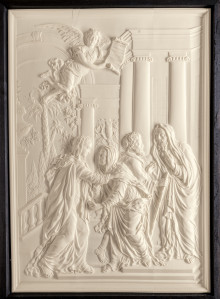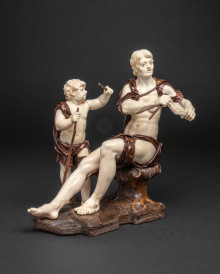A few years ago, the Liebieghaus Skulpturensammlung succeeded in making the most significant addition to its own holdings in the history of the museum: a collection of precious ivory sculptures of the Baroque and Rococo periods from the estate of the patron Reiner Winkler (1925–2020).
Since then, masterpieces by world-famous sculptors, such as “Fury on a Charging Horse” (1610), “The Three Parcae” (ca. 1670), “Chronos on the Globe” (ca. 1720/25?), and the “Allegory of Damnation in Hell (Anima Dannata?)” (1736) have been on display at the Liebieghaus in the exhibition “White Wedding”.
As of 2 June 2022, with the exhibition and new collection presentation “Splendid White”, the artworks that remained in Reiner Winkler's private collection until his death are now also accessible to Liebieghaus visitors. In the immediate vicinity of the first presentation, 21 selected works from a total of 31 statuettes, figure groups, and reliefs made of ivory, clay, and wood, which were brought to the Liebieghaus, cleaned, and photographed in the summer of 2020 are now on display.
Publication
Learn more in the exhibition publication. Available at the museum and in our online shop.
Portrait medallions and portraits of married couples, of noble personalities, private individuals, and dignitaries complete the collection presentation with outstanding works, including the “Portrait of Pope Clement XI” (ca. 1710), of which there are at least three versions. In addition to the portrait in the Liebieghaus, two others have survived in the Green Vault in Dresden and the V&A in London. As gifts of conversion from the popes, they were handed over to princely converts. It can be assumed that the Frankfurt medallion and likewise other versions were made and gifted for comparable, as yet unknown, specific occasions.
Large-format reliefs with Christian religious motifs and genre scenes, as well as impressive combination figures such as the “Beggar-Woman with Tamburin de Béarn and Child” (1730s), add essential exhibits to the previous collection presentation at the Liebieghaus.
Among the most beautiful and largest reliefs are the works “The Annunciation” and “The Visitation of Mary” (both ca. 1770–1780), which hung for a long time in a prominent position in Reiner Winkler’s home. The model for the Annunciation relief is known to be a copperplate engraving by Laurent Cars after a painting by François Lemoyne. In both reliefs, the sensitively drawn facial features, the elongated bodies with delicate limbs, and finely designed hair are striking. Carefully and softly pleated, beautifully lined robes shroud the figures. These characteristic features suggest an attribution of the two panels to the ivory carver Jean-Antoine Belleteste (1731–1811) from Dieppe.
Until the Reiner Winkler Collection was transferred to the Liebieghaus, the museum did not own any examples of the famous so-called combination figures made of ivory and wood. Since 2019, this genre has been presented in “White Wedding” with artworks by Simon Troger, Matthias Kolb, and unknown artists. With the combination figure “Beggar-Woman with Tamburin de Béarn and Child” (1730s) by Simon Troger and workshop, the series has been impressively expanded.
Troger specialised in the production of combination figures made of wood, ivory, and glass. In particular, the only scantily clad beggar figures and antique god figures in ideal nudity offered themselves as themes, with precious ivory being used for the unclothed parts of the body. Fabric remnants and garments were reproduced with precious woods.
As the works described exemplify, the consolidation of the Reiner Winkler Collection not only means a valuable expansion of the museum’s holdings: The collection presentation “Splendid White” now makes the beauty, virtuosity, and richness of variation of baroque ivory carving impressively tangible in its entirety.











